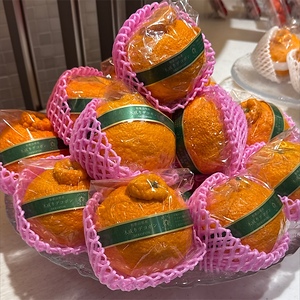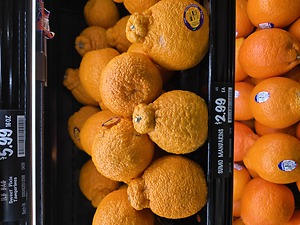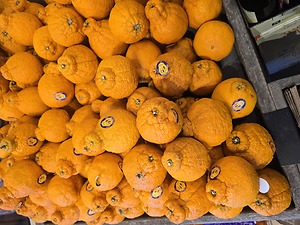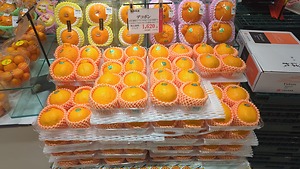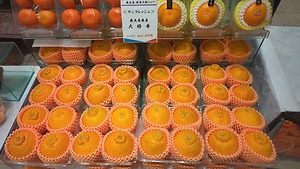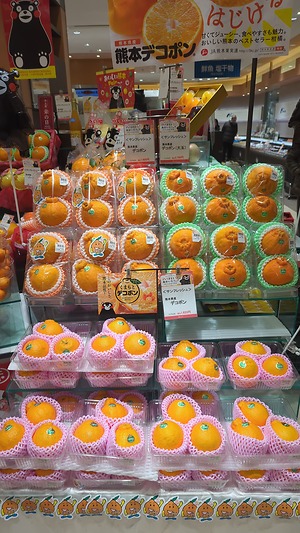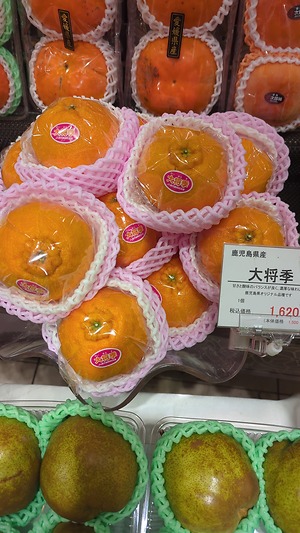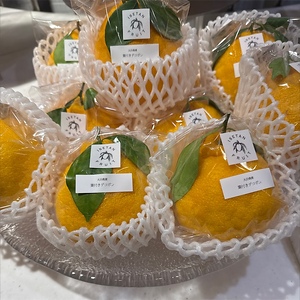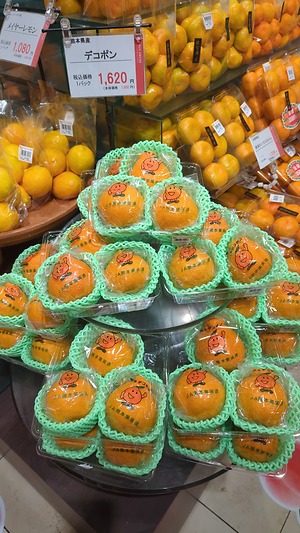


Dekopon Oranges
Estimated Inventory, lb : 0
Description/Taste
Dekopon oranges are a large varietal, averaging 8 to 10 centimeters in diameter, and have a round, oval, to oblate shape with a characteristic protruding furrowed neck, also referred to as a top knot in some markets. The rind is semi-thick but still easy to peel and showcases a light orange to yellow-orange hue. The rind is also covered in prominent oil glands, giving the surface a smooth, pebbled, bumpy appearance, and is delicate, bruising easily. Underneath the surface is a thin to almost nonexistent layer of white spongy pith, and the flesh is divided into 10 to 11 segments by edible white membranes. The flesh also has a firm but soft, tender, aqueous, and succulent pulpy consistency, either being found seedless or containing a few ivory seeds depending on cultivation. Dekopon oranges release a fragrant aroma when peeled, expelling essential oils through the pores on the surface. The flesh is known for having high sugar content, ranging from 13 to 18 degrees Brix. This high sugar is mixed with low acidity, containing less than 1 percent citric acid, to create a rich and sweet flavor without the zesty, tangy nuances commonly found in other orange varieties.
Seasons/Availability
Dekopon oranges are available in the late winter through early spring. Greenhouse-grown Dekopons are generally available in December, while outdoor-grown fruits are harvested in February and have a peak season in March through April.
Current Facts
Dekopon oranges, botanically classified as Citrus reticulata, are a Japanese hybrid variety belonging to the Rutaceae family. The large citrus was developed in the late 20th century under the name Shiranuhi but was initially disregarded due to its bumpy, unusual appearance. Over time, the variety was recognized for its flavor and became a popular cultivar, commercially grown across Japan under various names, including Dekopon, a protected brand name. Dekopon oranges eventually spread worldwide, known as Hellabong in Korea, Kinsei in Brazil, and Sumo Citrus® in the United States. Dekopon oranges are commercially grown in greenhouses and open fields, and the fruits are a labor-intensive variety, harvested and cured for 20 to 40 days to allow for the acidity to reduce, creating a sweeter taste. The oranges are also traditionally hand-harvested due to their delicate, easily bruised nature, and the fruits are generally picked and placed in small totes instead of the typical 900-pound commercial bins. Dekopon oranges were created to diversify the Japanese citrus industry, and the variety helped open export markets for Japanese citrus. Dekopon oranges are highly regarded for their rich, sweet flavor and large size consumed fresh, juiced, or zested for a wide variety of culinary applications.
Nutritional Value
Dekopon oranges are a source of vitamin C to strengthen the immune system, vitamin A to maintain healthy organ functioning, calcium to build strong bones and teeth, and iron to develop the protein hemoglobin for oxygen transport through the bloodstream. The oranges also provide fiber to regulate the digestive tract, potassium to balance fluid levels within the body, folate to develop RNA and DNA, and other nutrients, including magnesium, vitamin E, copper, and flavonoids.
Applications
Dekopon oranges have a rich, sweet taste suited for fresh preparations. The variety is primarily consumed straight out of hand and is eaten as a snack, palate cleanser, or healthy dessert. The oranges can be easily peeled, segmented, and served with yogurt, placed as a fresh topping over pancakes, waffles, and toast, or dipped whole in chocolate and sprinkled with crushed nuts. Dekopon oranges are often consumed fresh in Japan as it is believed the most nutrients will be ingested when served raw. The variety's firm but tender flesh can be tossed into salads, served in carpaccio, or chopped and added to salsas, dips, and raw dishes like ceviche. Try using the juice from Dekopons in marinades, dressings, sauces, and glazes. Dekopon oranges can also be zested or juiced for desserts and baked goods such as scones, cupcakes, cheesecakes, fudge, muffins, tarts, crème brulee, and meringue pies. In Japan, Dekopon oranges are a signature flavored candy produced by the brand Hi-Chew. Dekopon oranges pair well with herbs such as cilantro, mint, and parsley, fruits including apples, bananas, coconuts, and pineapples, meats such as poultry, steak, pancetta, and pork, seafood including shrimp, scallops, and white fish, and nuts such as pine, pistachios, cashews, and almonds. Whole, unpeeled Dekopon oranges will keep up to four days at room temperature and for 2 to 4 weeks when stored in the refrigerator.
Ethnic/Cultural Info
Dekopon is a brand name developed in Japan, established to create a uniform market. The moniker was said to be created by growers, and the name comes from the Japanese word "deko," meaning "bump" and "pon," referring to its Ponkan mandarin parent variety. Oranges labeled as Dekopon must meet specific quality requirements, including at least a 13 degrees Brix measurement of sugar and less than 1 percent or less of citric acid levels. If the fruits do not meet these requirements, they are generally labeled as Shiranuhi or Shiranui, named after their initial growing region in the Kumamoto Prefecture. Dekopon oranges are also known as Himepon in the Ehime Prefecture, Deko Momoe in the Saga Prefecture, and Hiropon in the Hiroshima Prefecture. Since their release, Dekopon oranges were one of the first commercial citrus varieties that encouraged trade and shipping agreements between Japan and other countries. This historical event was celebrated by building a monument to the variety in 2001 near JA Uki-Shiranui, the original birthplace of the citrus. The monument was constructed on the variety's tenth anniversary. In 2006, the Japan Fruit Growers Cooperative Association decreed March 1st to be Dekopon Day, a celebratory day to commemorate the 15th anniversary of the first shipments of Dekopons.
Geography/History
Dekopon oranges were developed in Japan in 1972 through the Ministry of Agriculture, Forestry, and Fisheries Fruit Tree Experiment Station in the Nagasaki Prefecture. The variety was a cross between the Kiyomi tangor, an orange and a satsuma mandarin hybrid, and a Ponkan, a popular citrus throughout Asia. When the variety was initially created, scientists deemed the oranges to be too irregular in shape for commercial markets, and the project was abandoned. Late in the 20th century, the variety was revisited at the Shiranuhi Agricultural Cooperative, now known as the JA Kumamoto Shiranuhi Branch in the Kumamoto Prefecture. Chairman of the Citrus Club, Ryuzo Ishihara, planted over 170 species of citrus to discover a new variety that could reinvigorate the citrus market in Japan. Dekopon, known as Shiranuhi at the time, was initially ignored in this test plot as the oranges are initially sour when harvested off the tree. Shingo Nagame, an employee of the agricultural cooperative, discovered that the variety lessens in acidity with time, developing a mild and sweet flavor. In 1985, Nagame showed the sweet oranges to other employees, spurring breeders to reexamine Shiranuhi oranges for commercial production. Shiranuhi oranges were released to markets in the 1990s and became a premium cultivar sold at high prices. The variety eventually expanded across Japan and was renamed Dekopon as a branded moniker, encouraging unification between Japanese growers. Dekopon oranges were introduced to the United States in 1998 through Brad Stark Jr. acquiring budwood from Japan. Stark sent the budwood to the Citrus Clonal Protection Program to clean the variety of possible diseases, and it took several years before the budwood was released. During this time, Stark's business in Strathmore, California, closed, causing him to sell the sterilized budwood to the Griffith family in 2005. The Griffith family was known for their ownership of the nursery TreeSource and Suntreat Packing and Shipping, and after buying the rights to the Dekopon budwood, they had thirteen different growers cultivating the variety in local groves throughout the San Joaquin Valley by 2008. These growers were sworn to secrecy, having to sign a confidentiality agreement, and if anyone ever asked about the new trees, they were required to call the variety XP1. In 2011, the first crop of American-grown Dekopons was released to commercial markets under the brand name Sumo Citrus®. Today Dekopon oranges are commercially grown worldwide in Asia, especially in Japan, Korea, and China, Australia, Brazil, the United Kingdom, and the United States. In Japan, the variety is mainly produced in the Kumamoto, Ehime, Wakayama, Aichi, and Oita Prefectures.
Recipe Ideas
Recipes that include Dekopon Oranges. One



